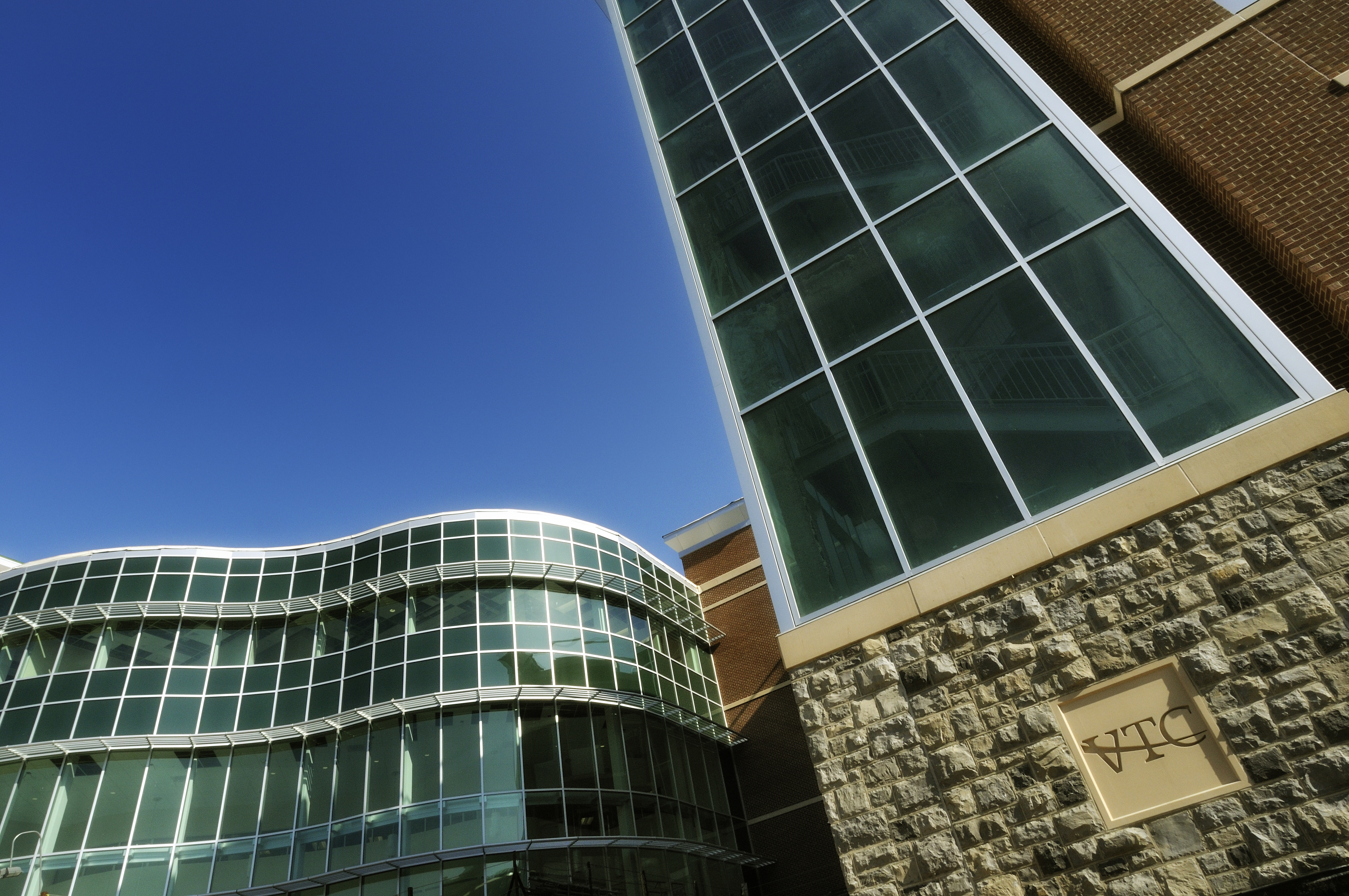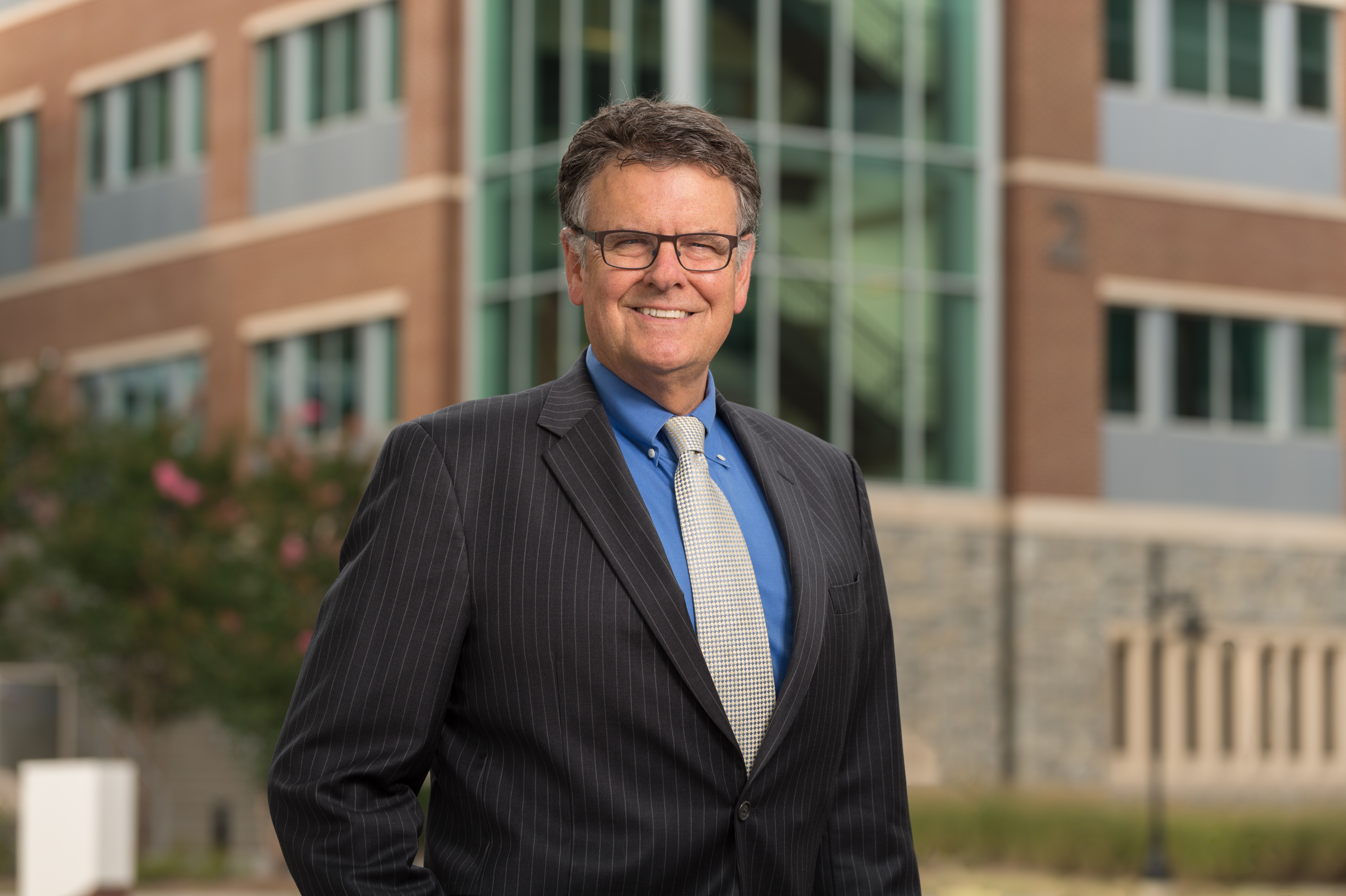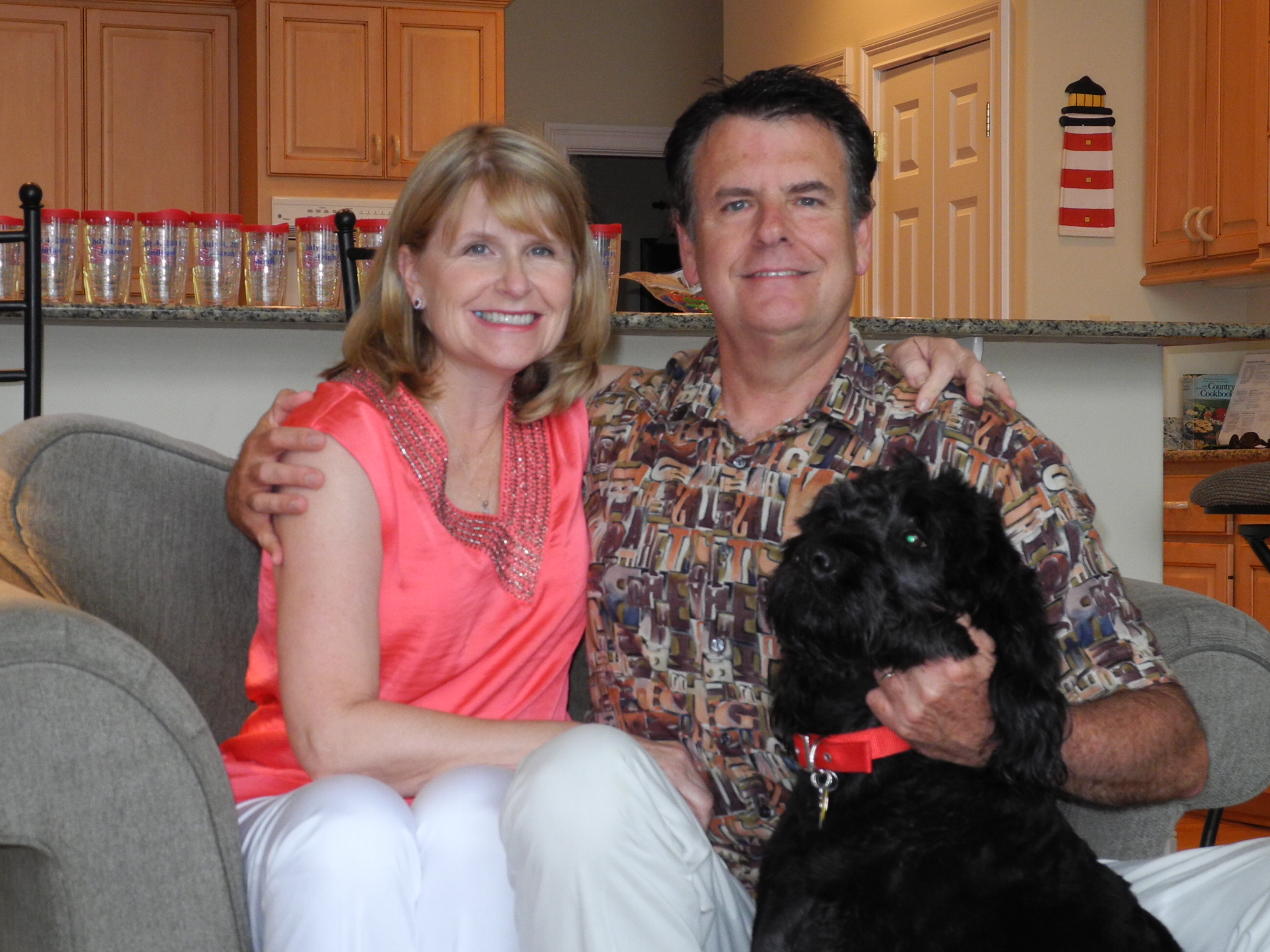
VTCRI and the Virginia Tech Carilion School of Medicine occupy a modern facility in Roanoke.
Construction was under way on campus when I came to Roanoke to interview for the position of founding executive director of the Virginia Tech Carilion Research Institute.
At the time, I was chair of the Department of Neuroscience and director of Neuroscience Initiatives at the Baylor College of Medicine, at the Texas Medical Center in Houston.
For people who haven’t seen it, the Texas Medical Center presents a striking image as the largest medical complex in the United States, brimming with discovery, diversity, and economic vibrancy, with more people working there than who live in the city of Roanoke. It is a well-established living health sciences ecosystem—nothing like what I was about to see in the nascent medical center just taking shape in Roanoke.

Dogged connections: Michael Friedlander and his labradoodle, Grayton, were constant companions during the early days at VTCRI. Grayton died of cancer in 2015, surviving almost five years after his diagnosis thanks to experimental treatments, some administered at the Virginia-Maryland College of Veterinary Medicine.
I parked near the construction site and walked around. Melting snow was turning into puddles on the ground. Not many people were in sight. The campus looked sparse except for the existing clinic and the emerging edifices of the soon-to-be-completed research institute and school of medicine. It looked like what it was—a former reclamation site. One had to squint a bit and exercise imagination to get a sense of what it would be like going forward.
However, my confidence in the plans to create an innovative new model medical school and biomedical research institute grew as I had the opportunity to meet the leadership, including then-University President Charles Steger at Virginia Tech and then-Carilion Clinic President and CEO Ed Murphy. It didn’t take long before I was able to see their vision that this could really be something spectacular. My wife Sandra and I also saw the hope and promise of a vibrant, talented, and welcoming community in which we would be able to plant our stake for the future.
Although other opportunities for taking on major leadership roles at more established academic health centers were being presented to me, I kept thinking, how often in life do you get a chance to contribute to building something brand new with the potential to positively impact so many peoples’ lives? Before my time at Baylor College of Medicine, I founded the University of Alabama at Birmingham’s Neurobiology Research Center, the Department of Neurobiology, the Neurobiology Graduate Program, and the Evelyn McKnight Foundation Brain Initiative there. Each of those endeavors was extremely satisfying and rewarding, as I was able to watch them grow while sharing in the successes of the many outstanding faculty, staff, and students who were recruited and worked so hard to build them.
But never before had I been given the privilege to launch such a massive undertaking with an almost blank slate. During its history, Virginia Tech has had profound impact in many areas of education, research, and service, particularly in engineering, with multiple pockets of excellence in the life sciences spread across several colleges and institutes with broader missions. But this would be a new entity with a singular focus, an individual mission of excellence in biomedical research and a plan to build a new partnership between two of the commonwealth’s most significant institutions in higher education and health care–Virginia Tech and Carilion Clinic.
It was a first. How could I say no?
The doors of the VTCRI opened on Sept. 1, 2010. I remember it well. The medical school had opened a few weeks earlier, so there was at least some life, thanks to the fresh, new students. But on the research institute side of the building, there was literally no one—except me, a couple of hardy Virginia Tech staff, including Gary Mason, who guided me through the Virginia Tech processes and led the many needed building changes (and my labradoodle, Grayton, who visited often in the early days). Those first few days were spent alone, with all the challenges one would expect in a brand new, nearly empty building and starting a new program between two large institutions—even communicating with new colleagues in Blacksburg and at Carilion Clinic across multiple (and different) security layers.
Then, very quickly, things started to hum. first couple of years were a recruiting blitz. We interviewed people from all over the world, hosted visitors, and had seminars—literally something every day.

Thirteen year old labradoodle Grayton Friedlander died of cancer in 2015. Grayton moved to Roanoke from Houston with Michael and Sandra Friedlander and was one of the original “founders” of the Virginia Tech Carilion Research Institute. He survived almost five years after his initial diagnosis at Virginia Tech by receiving innovative experimental treatments at both the Virginia Tech and University of Florida veterinary schools. According to Friedlander, “we had almost five great additional years with Grayton, thanks to the innovative compassionate care and leading edge science provided to him by the vets at Virginia Tech and their colleagues at Florida. The new VTC Biomedical Research Addition will provide exciting new opportunities for development of improved therapies for humans and other dogs like Grayton.”
Before you knew it, we had achieved some critical mass. In particular, we were fortunate to be able to attract some of the world’s top talent in neuroscience or brain research right out of the gate from the very Texas Medical Center from where I had come. Star neuroscientists, such as Read Montague, Stephen LaConte, Pearl Chiu, and Brooks King-Casas, joined us from Houston along with their research teams, including students. Very soon thereafter, renowned addiction researcher Warren Bickel and his team joined us from Little Rock, Arkansas, as did Sharon and Craig Ramey, leading child development scientists from Georgetown University in Washington, D.C. Coupled with highly talented support staff already here in Roanoke who joined our team, including Gary Mason, who was instrumental in designing the research space and also joining us from Houston; Justin King, who developed our information technology infrastructure; and Cathy Davis, who launched our grants management office, which Sherri Cook led through the following years of program and grant portfolio development, we were off to the races.
It was very soon thereafter, when additional research team leaders, including Debbie Kelly from Harvard; Jamie Tyler from Arizona; Rosalyn Moran from London; Sarah McDonald from the National Institutes of Health in Bethesda, Maryland; Konark Mukherjee from Brandeis in Boston; and Zhi Sheng from U. Mass. in Worcester, formed the next wave of teams to arrive. They were followed by the teams of cardiovascular researchers led by distinguished regenerative medicine scientist and entrepreneur Rob Gourdie from Charleston, South Carolina, and the other heart research team leaders, including Jamie Smyth from Los Angeles; John Chappell from Chapel Hill, North Carolina; and Steve Poelzing from Salt Lake City, Utah.
The brain research programs also continued to grow substantially with the arrival of Greg Valdez from Harvard; Mike Fox from Virginia Commonwealth University in Richmond; Sarah Parker from Georgetown in Washington, D.C.; Alexei Morozov from the NIH in Bethesda; Albert Pan from Medical College of Georgia in Augusta; Harry Sontheimer and Stefanie Robel from the University of Alabama-Birmingham. Add the recruitment of Ken Oestreich, a rising star immunologist from the University of Washington in Seattle, and the diversity and breadth of talent at the VTCRI comes into focus.
It wasn’t the Texas Medical Center with over 100,000 employees, but we got to nearly 100 people in the middle of the first year—including some very accomplished, eminent scientists who saw great opportunity for innovation and discovery-based entrepreneurism. In a short time, we had traveled quite a distance from the days when everyone at the VTCRI could fit around one table to our current staff of faculty, staff, and students at well over 300 along with many of their families as well. In just seven years, the research institute has won over $100 million in new outside research funding of which $80 million in funded projects are active now, supporting medical breakthroughs, spinning off companies, attracting diverse scientists and students from around the nation and world, and providing jobs for people who live in the valleys.
Today, it’s hard to remember those “old days” when the research institute was a lofty ambition, the School of Medicine was a glint in founding dean Cynda Johnson’s eye, and the Health Sciences and Technology Campus that sprouted around them was even less conceivable.
But reminders of that not-so-distant past are becoming more prominent. Once again, this time on a fenced-in area on what had been a parking lot in the center of the Riverside campus off Jefferson Street, earthmovers and construction crews are working. In the next two years, a new building will rise—the Virginia Tech Carilion Biomedical Research Addition. The 139,000-square-foot facility will provide space for another 25-30 research teams, who are eager to solve 21st-century health challenges. The addition is expected to promote the economic vitality of Southwest Virginia by providing new, high-paying jobs; bringing many more students to the community; and winning highly competitive research grants. The growth is also expected to offer opportunities for increasing vibrancy in the public-private sector as new companies spin out from the work at the research institute and partnerships between VTCRI teams and established industries from across the U.S. and around the globe expand.
And, as before, where once there was a vision, the Virginia Tech Carilion partnership is creating something amazing—a new achievement in which the entire Virginia Tech community, no matter where they may be in the world, can take pride. The new leadership—President Tim Sands at Virginia Tech and President and CEO Nancy Agee of Carilion Clinic–have embraced the vision and brought new commitment and energy to the enterprise, propelling it to the next level.
Our five daughters are grown and raising their own families, including our six grandchildren, in various cities along the East Coast. Sandra and I are headed into the next phase of this partnership with the beautiful people of this wonderful community and the great institutions of Virginia Tech and Carilion Clinic along with our new dog, Baylor (labradoodle Grayton died after five years in Roanoke following a battle with cancer). It is fitting because Baylor is a rescue pup who was found on a highway in Houston near the Baylor College of Medicine, from where the founding group of leadership and scientists came to VTCRI, reminding us that history is important for all of us, as is the bright future ahead.
Michael J. Friedlander is the vice president for health sciences and technology for Virginia Tech and the founding executive director of the Virginia Tech Carilion Research Institute.